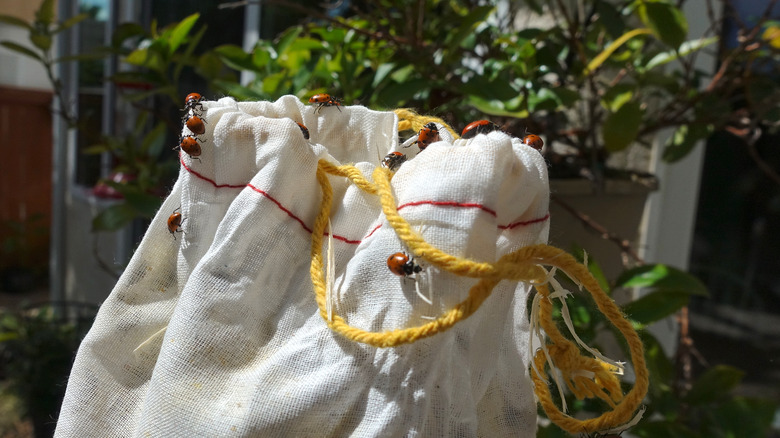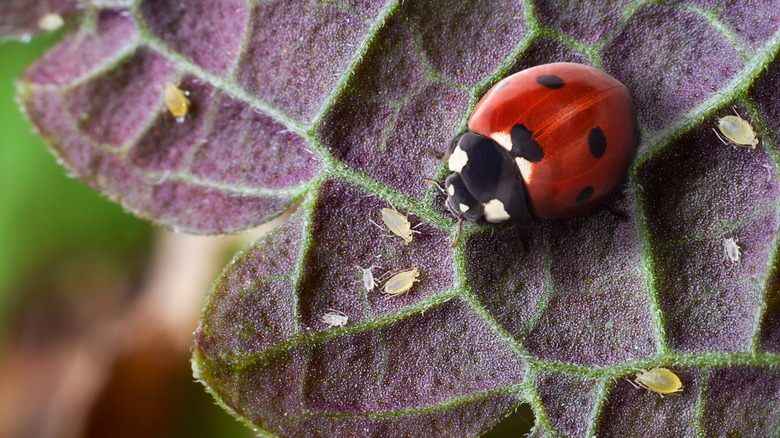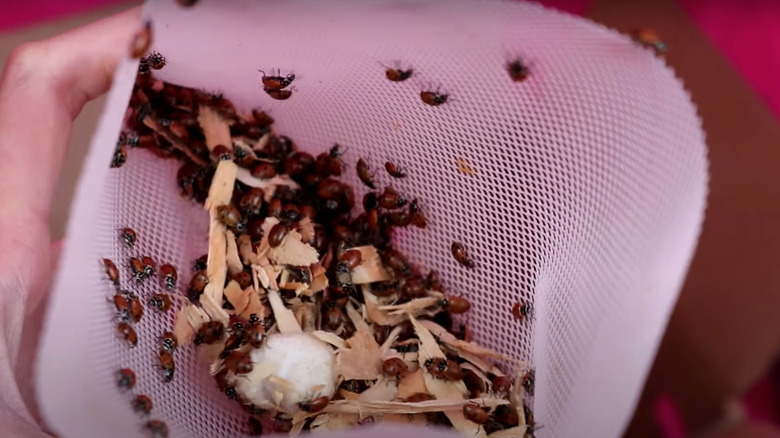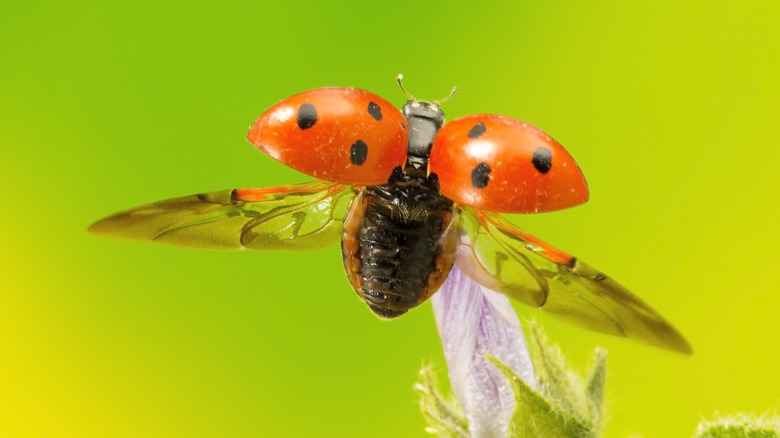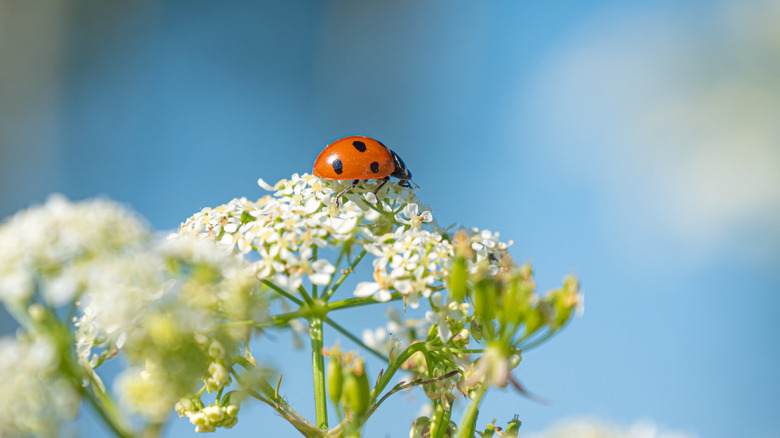Should You Buy Ladybugs For Natural Garden Pest Control?
Organic gardeners do their best to make sure their gardens are environmentally friendly, but even some practices that are all natural can be bad for the ecosystem. In its most basic form, organic gardening means not using synthetic fertilizers or artificial agricultural chemical pesticides. This leaves a lot of room for interpretation of what is and is not organic beyond the realm of pest control and fertilization. It also means that just because something is considered organic does not mean it is safe for humans, pets, or the environment. The practice of purchasing ladybugs is one such controversy. While it may be better than synthetic pesticides, importing insects into your garden may not be the best way to control pests.
Before we dive into the pros and cons of purchasing ladybugs, let's define the insects we are discussing. You probably hear the terms ladybug and lady beetle used interchangeably. Most of us grew up calling them ladybugs — and probably always will — although lady beetle is more accurate. They are in the Coleoptera family of insects and not a true bug that would be included in the Hemiptera family. Sometimes you'll hear the native beetles called ladybugs and the non-native insects called Asian lady beetle. Those are just commonly used references. Some people even still call this family of insects ladybirds. Ultimately, ladybugs, lady beetles, and ladybirds are in the same family, although there are some differences between native and non-native populations, which we will discuss.
Pros of buying ladybugs
Although the benefits of purchasing ladybugs for your garden may be up for debate, the overall benefits of having ladybugs for pest control are not. The larvae of ladybugs are eating machines, consuming small pests like mites and aphids, and the larvae and eggs of larger insects. If you have ever had an aphid infestation, then you understand how much damage those little buggers can do. In its lifetime, a single ladybug can eat up to 5,000 aphids. When you consider that a female ladybug lays around 300 eggs, even if a fraction of those eggs reach the larvae stage, that's a lot of pest control! So, it's no wonder it's tempting to take a shortcut and buy these insects.
Both native and non-native ladybugs offer the same pest control benefits in the garden, but Asian lady beetles get a bad reputation even though they are helpful. Of course, part of that reputation comes from problems when they flock indoors during cold weather. They occasionally bite, causing a minor reaction, although it's uncommon. Fortunately, they do not eat healthy crops, infest wood, or carry diseases. Overall, Asian lady beetles are beneficial for pest control — as long as they stay outside.
Introducing ladybugs into your enviornment
If you discover your garden is entirely devoid of ladybugs, purchasing them may be your only option to reintroduce them into your space. In areas with new construction, there are very few natural sources of food for these insects. This is also a problem in areas with heavy pesticide use, like neighborhoods that spray heavily for mosquitoes or ticks. These conditions make it difficult for ladybug populations to get established, so releasing ladybugs early in the season may provide natural pest control for your garden. When released properly, you may be able to avoid harsh insecticides. Even some organic pesticides are indiscriminate — they kill good bugs, like pollinators, along with bad ones. Ladybugs will never harm a bee or a butterfly.
You can encourage your purchased ladybugs to hang around your garden by misting them lightly in the bag and storing them in the refrigerator until you are ready to release them. These little beetles also need a steady food supply. Releasing your ladybugs after an aphid infestation has appeared will keep them from flying away for food. Once your ladybugs are well-hydrated from being misted, and you know you have a food source available, release the insects in the evening near the ground. They will fly up in search of food and find an ample supply in your garden. Hopefully, they will identify your space as a good place to spend the summer.
Cons of buying ladybugs
There are a few things to seriously consider before purchasing and releasing ladybugs into your garden. According to ABC10, most of the ladybugs harvested and sold in the U.S. come from the foothills of the Sierra Nevada Mountains in California. A native species of ladybug, the Convergent Ladybeetle, migrates there in massive numbers to hibernate for the winter. The problem is this is a federal forest, and while it was once legal to harvest these insects from this location, the permits have since been revoked. This means that most of the native ladybugs sold are poached. Yes, people are poaching ladybugs for big profits.
Another problem with purchasing ladybugs is that the vast majority will fly away. North Dakota State University states that upon release, the bulk of your investment will fly over 20 miles away, with less than 1% actually remaining in your garden. Apparently, you can lead a ladybug to aphids, but you cannot make them eat.
How to naturally attract ladybugs to your garden
Now that we know that you are unlikely to have a successful release of purchased ladybugs in your garden and that the legality of those insects is questionable, how do you attract ladybugs and encourage them to stay? The first step is adding some of their favorite plants to your garden. They are generally attracted to small blooms with thick foliage in which to hide and lay their eggs. Yarrow, dill, and tansy are just a few lovely garden additions that will attract these little beetles.
This tip may be a little harder to follow, but it is worth sacrificing a few plants for a lifetime supply of ladybugs. These insects need a food source for when their eggs hatch, and we know that the larvae want to eat bugs! If you can leave a few infested plants as a food source for ladybugs, you may never have a shortage again. The adult ladybugs hibernate in dead foliage over the winter, ready to emerge and lay eggs in the spring. Those eggs will hatch with larvae ready and willing to eat soft-shelled pests when they arrive, and if you're lucky, you may avoid future infestations.
